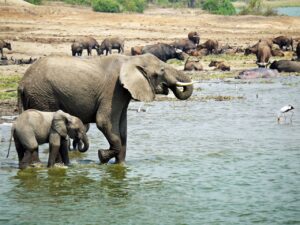Elephants
Elephants, the largest terrestrial animals on Earth, are members of the Elephantidae family, consisting of two primary species: Asian and African Elephants. They hold profound cultural and historical importance in many societies. They are honoured as symbols of wisdom, power and strength in various cultures around the world. They have been depicted in ancient mythology, art and religious practices, often representing auspiciousness, loyalty, and spirituality.
These giant creatures play a crucial role in their ecosystems. As mega herbivores, they shape the environment by creating water holes, clearing pathways through dense vegetation, and dispersing seeds through their dung. Their search for wild food resources can influence the structure of plant communities and contribute to forest regeneration.
Let us uncover the awe-inspiring world of these majestic creatures, where intelligence meets magnificence and society thrives on loyalty. Get ready to delve into the 10 mind blowing facts that we never knew ever existed that will reshape our perception of these majestic creatures.
Largest Land Animal
- Elephants are the largest of the land animals on Earth.
- This title goes to the African Elephants, with males weighing up to 12,000 pounds (5,400 kilograms) and standing over 10 feet (3 metres) tall.
- On the other hand, Asian Elephants can reach upto a height of about 10 feet and weigh around 11,000 pounds, which is similar to the weight of a small car.
Highly Intelligent
- These large mammals are known for their exceptional intelligence.
- They display complex problem-solving skills, exhibit self-awareness, show empathy, and have remarkable memory capabilities.
Emotional Beings

- These gentle giants exhibit a wide range of emotions. They can experience joy, grief, compassion, and even have been observed mourning their dead.
- They form strong social bonds within their herds and display a high level of empathy towards their counterparts and sometimes even other species.
Incredible Communication
- These creatures communicate through a variety of methods, including vocalisations, body language, and infrasound.
- They make a variety of different sounds, including some that are too low for humans to hear.
- They can use low-frequency vibrations called infrasound, to communicate with each other over long distances and stay connected with their group.
- They have impressive control and coordination of their trunks, which allows them to perform precise tasks and manipulate objects with great skill.
Trunk Dexterity
- An elephant’s trunk is incredibly versatile and acts as a combination of a nose and upper lip. It contains over 40,000 muscles and can perform delicate tasks like picking up a tiny object or exerting enormous strength to uproot trees.
- They exhibit remarkable ingenuity and have been observed using tools, such as sticks or branches, to reach food sources that are otherwise out of reach.
Extraordinary Ears
- These large mammals have incredibly large ears, which serve multiple purposes.
- Besides hearing, their ears help regulate body temperature by radiating excess heat, and they can also communicate mood and intentions through ear postures.
Lifespan and Matriarchal Society
- These animals have long lifespans, often living up to 60 years or more in their natural habitat.
- They live in matriarchal societies led by the oldest and most experienced female, who guides the herd’s movements and imparts knowledge to the younger generations.
- Similar to humans, elephants also experience ageing, exhibiting visible signs of wrinkles and grey hair as they grow older.
Excellent Swimmers and astonishing speed

- There is a belief that these creatures are excellent swimmers.
- They have the remarkable ability to use their trunks as a snorkel and their four legs to paddle, enabling them to traverse rivers and swim over long distances, much like humans using snorkels and swimming with all their limbs.
- Despite their massive size, elephants are surprisingly agile and can achieve remarkable speed.
- These large giants can reach impressive speeds of up to 25 miles per hour, enabling them to swiftly move through their expansive habitats when needed, similar to how humans can run at high speeds to navigate their surroundings quickly.
- Their robust legs and muscular build enable them to move swiftly while also bearing the weight of their gigantic bodies.
Environmental Engineers
- Seed Dispersal: These mammals often consume a wide variety of plant species in their diet. As they travel and forage for food, the seeds of the plants they consume pass through their digestive systems and are later deposited in different locations through their droppings. This process, known as endozoochory, aids in the dispersal of seeds. By planting seeds in new areas, these animals contribute to the natural regeneration of plant species, promoting biodiversity in their habitat.
- Vegetation Management: Large mammals influence their environment through their feeding habits. They graze on vegetation and may selectively browse on certain plant species. This browsing behavior can shape the plant composition in their habitat. Some plants may benefit from the pruning effect of herbivores, encouraging new growth and increasing plant diversity. Others might thrive in areas less frequented by these mammals.
- Trail Creation: These mammals can create trails or pathways through their regular movements. As they traverse their environment, they may trample over undergrowth and dense vegetation, effectively creating open pathways. These trails not only facilitate their own movements but also provide easier access for other wildlife, allowing for increased mobility and resource utilization.
- Water Hole Formation: Some large mammals engage in behaviors like digging or wallowing, particularly during dry seasons. These activities can lead to the formation of depressions in the ground that collect rainwater, creating temporary water holes. These water sources become critical for various animals, especially during times of water scarcity, contributing to the overall well-being of the ecosystem.
- Nutrient Recycling: These mammals are integral to nutrient cycling within ecosystems. They consume organic matter and vegetation, which they break down during digestion. When they excrete waste in the form of feces and urine, they return vital nutrients to the soil. This nutrient enrichment promotes plant growth and enhances the overall health of the ecosystem.
Threatened by Human Activities
- Despite their awe-inspiring qualities, these giants face numerous threats from human activities such as habitat loss, poaching and human-wildlife conflict.
- Conservation measures are crucial to mitigate these threats and ensure the survival of these majestic creatures for future generations. Efforts may include the establishment of protected areas, anti-poaching initiatives, habitat restoration, and community-based conservation programs.
Conclusion:
The importance and fascination of elephants stem from their cultural significance, ecological impact, conservation efforts, impressive size, dietary adaptations, memory and intelligence, social complexity, and unique physical features. Gaining a deep understanding and recognizing the significance of the aspects of these large mammals helps us develop a greater appreciation for their importance in the natural world. It reinforces the urgency to protect and conserve them, acknowledging the essential role they play in our own human existence.
Do Read: Elephant Facts
FAQs
Q: How long do elephants live?
A: Elephants in their natural habitat can live up to 70 years or even longer .
Q: How many distinct types of elephants exist?
A:There are currently three recognized species of elephants: African Savannah elephants, African Forest elephants, and Asian elephants.
Q: Why are elephant tusks valuable?
A: Elephant tusks are composed of ivory, a material highly valued for its aesthetic appeal and uses in various industries such as traditional craftsmanship.
Q: What are the different methods of communication by elephants?
A: Elephants use various methods to communicate with each other like making different sounds, using body language and gestures, and even using low-frequency vibrations that can travel long distances through the ground.
Q: What contribution can we make for the conservation of elephants?
A: Supporting conservation efforts, spreading awareness, and avoiding products made from ivory can contribute to the conservation of these majestic creatures by we human beings.

2 thoughts on “10 astonishing Elephant facts we never knew ever existed.”